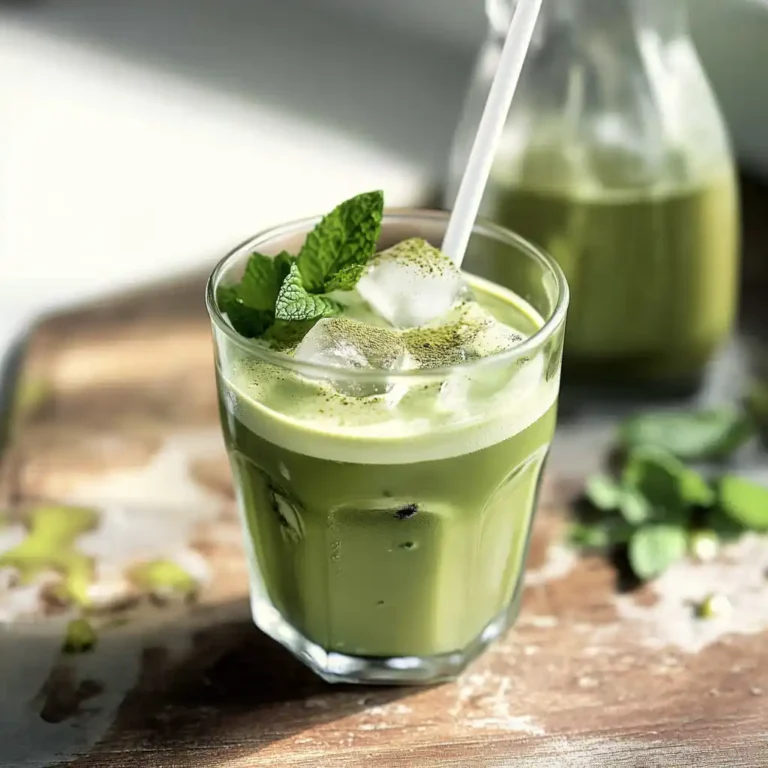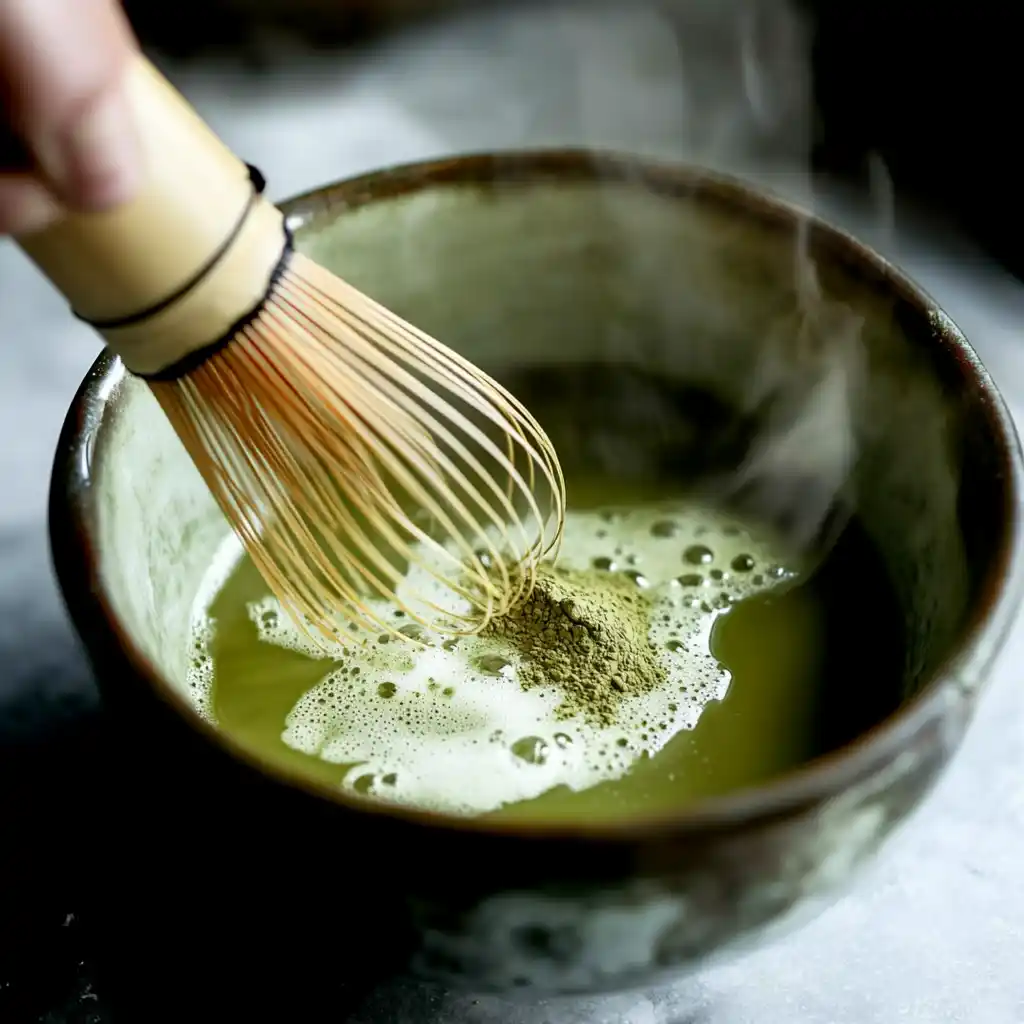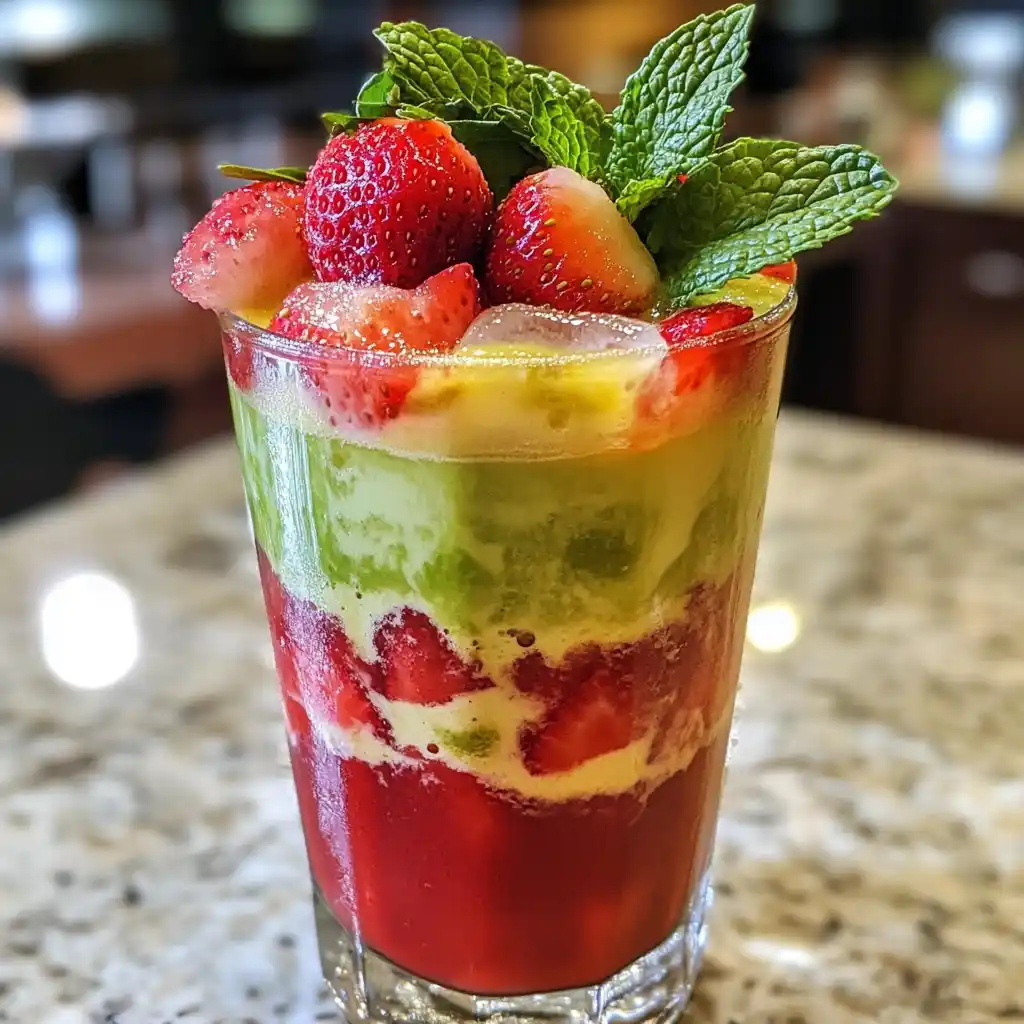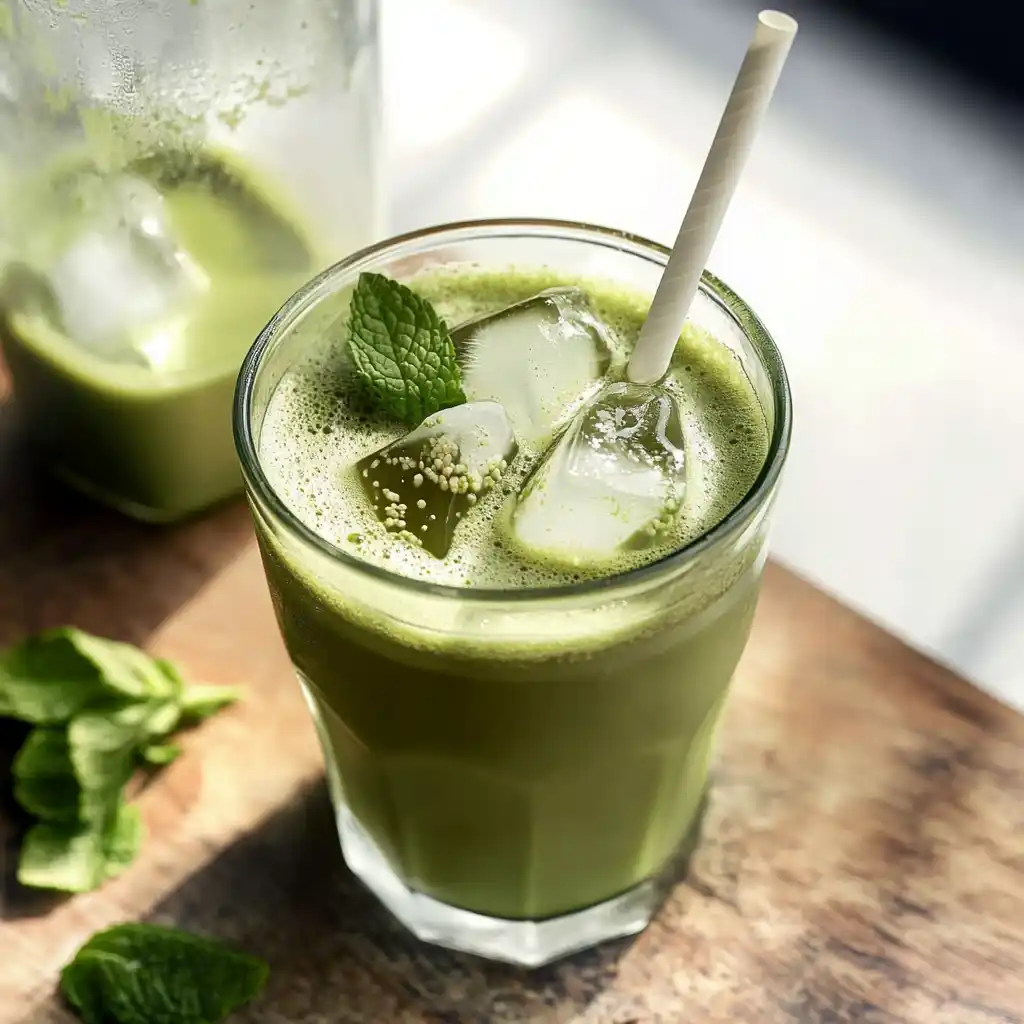If you’ve ever looked for a drink that’s light, refreshing, and energizing without the sugar overload, the low calorie iced matcha latte is your answer. This green tea-based drink is quickly becoming a favorite among those who want flavor and wellness in one glass. I’m one of them—and here’s why.
My journey with healthy recipes like this low calorie iced matcha latte began in a cozy seaside kitchen, where food was a form of love. I grew up learning that what you cook matters—but how you make people feel with it matters even more. That belief shaped the way I approach food today.
One of my earliest kitchen memories was helping sprinkle herbs over freshly rolled dough. Over the years, I’ve turned that childhood curiosity into a passion for creating feel-good recipes—like this iced matcha drink that’s full of antioxidants and friendly to your waistline.
Now, when I crave something cool and satisfying, I make my own low calorie iced matcha latte at home. It’s creamy, slightly sweet, and made with simple, nourishing ingredients that support energy and wellness—without the guilt.
Whether you’re new to matcha or just want a smarter version of your usual order, this guide will show you how to enjoy a low calorie iced matcha latte that fits into any lifestyle.
Learn more about the health benefits in our matcha tea guide.
Table of Contents
Introduction to Low Calorie Iced Matcha Latte
What Is a Low Calorie Iced Matcha Latte?
A low calorie iced matcha latte is a chilled, creamy green tea drink made with matcha powder, a milk alternative (like almond, oat, or coconut milk), ice, and a low- or zero-calorie sweetener. It’s the lighter version of a traditional matcha latte—crafted to deliver the same earthy flavor and energy boost with fewer calories and less sugar.
Unlike store-bought versions that can sneak in syrups, sweetened milks, and whipped toppings, a true low calorie iced matcha latte keeps things clean. Most homemade or modified café versions can range from 40 to 90 calories, depending on how it’s made.
Here’s a quick comparison:
| Drink Type | Calories (Avg) | Sugar (g) | Fat (g) |
|---|---|---|---|
| Regular Iced Matcha Latte | 180–250 | 20–30 | 4–7 |
| Low Calorie Iced Matcha Latte | 40–90 | <5 | 1–3 |
Choosing lighter ingredients helps you enjoy the benefits of matcha—like antioxidants, metabolism support, and steady energy—without the crash or calorie overload. Whether you make it at home or order it smart at a café, it’s a delicious way to stay on track with your health goals.
Why Is It Trending Among Health Enthusiasts?
So why is everyone talking about the low calorie iced matcha latte lately? Simple—it offers a perfect blend of taste, wellness, and control. With its bright green hue, smooth texture, and earthy-sweet flavor, matcha is visually appealing and health-forward. But here’s what’s making it a favorite in the wellness world:
- Low Sugar, Big Flavor
With the right ingredients, you can cut the sugar and still enjoy a rich, satisfying sip. - Plant-Based Friendly
Using unsweetened almond milk, oat milk, or cashew milk keeps it dairy-free and easy on digestion. - Long-Lasting Energy
Unlike coffee, matcha contains L-theanine, which helps smooth out caffeine’s effects, giving you calm, focused energy for hours. - Customizable to Your Diet
Low-carb? Keto? Vegan? Gluten-free? You can tailor your iced matcha to fit any dietary plan. - Supports Weight Management
Drinking a low calorie iced matcha latte can be a smart part of a weight loss routine—low in calories, rich in antioxidants, and known to support fat oxidation.
Looking for inspiration? Try our iced strawberry matcha latte recipe for a fruity twist.
And if you want something spoon able and energizing, don’t miss our matcha chia pudding recipe for a grab-and-go treat.
In the next section, we’ll break down what makes matcha so powerful—nutritionally and scientifically.
Print
Low Calorie Iced Matcha Latte: The Ultimate Guide to a Guilt-Free Green Boost
This low calorie iced matcha latte is light, energizing, and perfect for wellness lovers. With creamy almond milk, earthy matcha, and no added sugar, it’s the ultimate healthy green drink to refresh and fuel your day.
- Total Time: 5 minutes
- Yield: 1 drink 1x
Ingredients
- 1 tsp ceremonial or high-quality culinary grade matcha powder
- 3–4 oz hot water (175°F, not boiling)
- ¾ cup unsweetened almond milk (or oat, soy, or coconut milk)
- ½ tsp monk fruit or stevia (optional)
- Ice cubes
- Optional: dash of cinnamon or vanilla extract
Instructions
- Sift 1 tsp matcha into a small bowl to remove clumps.
- Add 3–4 oz hot water and whisk using a bamboo whisk or frother until smooth and frothy.
- Stir in monk fruit or stevia, if desired.
- Fill a glass with ice cubes, pour in almond milk.
- Top with the matcha mixture and stir well to combine.
- Optional: Add cinnamon or vanilla for extra flavor. Enjoy immediately.
Notes
Use unsweetened plant-based milk and a zero-calorie sweetener to keep this drink under 80 calories. You can prep the matcha concentrate in advance and refrigerate for up to 3 days. For a protein boost, blend with unflavored collagen or plant-based protein powder.
- Prep Time: 5 minutes
- Cook Time: 0 minutes
- Category: Drinks
- Method: No-Cook
- Cuisine: Healthy
- Diet: Vegan
Nutrition
- Serving Size: 1 drink
- Calories: 60
- Sugar: 0g
- Sodium: 50mg
- Fat: 3g
- Saturated Fat: 0.5g
- Unsaturated Fat: 2.5g
- Trans Fat: 0g
- Carbohydrates: 4g
- Fiber: 1g
- Protein: 2g
- Cholesterol: 0mg
Keywords: matcha, iced matcha, low calorie latte, healthy drinks, vegan, energy drink
Nutritional Benefits of Matcha
How Matcha Supports Metabolism and Energy
When it comes to energy without the crash, matcha is in a league of its own. The core ingredient in a low calorie iced matcha latte—finely ground green tea leaves—delivers a steady boost thanks to a unique compound called L-theanine. Unlike coffee, which spikes your system and drops you fast, matcha offers a calm alertness that lasts for hours.
Here’s what makes matcha a nutritional powerhouse:
- Caffeine + L-theanine Combo
This dynamic duo promotes sustained focus and energy while minimizing jitters and crashes. A typical serving of matcha contains 30–70 mg of caffeine—enough to energize you without overwhelming your nervous system. - Boosts Thermogenesis
Matcha has been shown to increase thermogenesis, the body’s rate of burning calories, by up to 35–43%. This makes it a supportive drink for those looking to shed weight while staying energized. - Enhances Endurance
Studies show matcha can help improve endurance during workouts, making it a great pre-exercise beverage when served cold in a low calorie iced matcha latte. - Naturally Detoxifying
Because it’s shade-grown, matcha contains higher levels of chlorophyll than other green teas. This helps naturally detoxify the body and remove heavy metals and toxins.
Discover great ideas like other metabolism-friendly drinks in our green tea drink recipe for a healthy boost.
Antioxidants and Detox: Why Matcha Is a Superfood
Matcha isn’t just a drink—it’s a nutritional superfood in powdered form. The vivid green color is more than eye candy; it’s a sign of the rich antioxidant content, especially EGCG (epigallocatechin gallate), one of the most powerful compounds in green tea.
Let’s break it down:
| Nutrient in Matcha | Health Benefit |
|---|---|
| EGCG (Catechins) | Fights inflammation, supports heart health, aids fat burning |
| Chlorophyll | Detoxifies and alkalizes the body |
| L-Theanine | Boosts brain function and reduces stress |
| Vitamin C | Supports immune health |
| Fiber | Helps with digestion and satiety |
Matcha contains over 137x more antioxidants than regular green tea. So when you sip a low calorie iced matcha latte, you’re doing more than cooling off—you’re protecting your body from free radical damage and inflammation.
And because it’s low in sugar and dairy-free when made right, this iced latte is gentle on the gut and easy to digest.

Want to learn even more about matcha’s health benefits? Don’t miss our deep dive in the matcha tea guide.
What Adds Calories to a Matcha Latte?
Common High-Calorie Ingredients to Watch For
While a low calorie iced matcha latte sounds like a smart choice—and it is—it can easily become a sneaky calorie bomb if you’re not careful. Most people don’t realize that their favorite green drink can tip over 200 calories with just a few wrong ingredients.
Here’s what usually drives up the calorie count:
- Sweetened Matcha Powder
Some pre-made matcha blends already contain sugar or powdered milk. If you’re not reading the label, you’re likely adding 15–20 grams of sugar before the drink is even mixed. - Whole Milk or Creamer
One cup of whole milk adds around 150 calories and 8g of fat to your drink. Creamers—especially flavored ones—can add even more, along with artificial sweeteners and oils. - Flavored Syrups
Vanilla, honey, and caramel syrups can sound healthy but are often loaded with refined sugar. Just one pump adds 20–30 calories, and most lattes use three or more. - Whipped Cream or Toppings
Not common with matcha, but if added, they can tack on 60–100 extra calories with no real nutritional value.
Here’s a quick breakdown of calorie traps:
| Ingredient | Calories (per serving) | Concern |
|---|---|---|
| Sweetened Matcha Powder | 70–100 | Hidden sugar |
| Whole Milk | 150 | High fat & calories |
| Vanilla Syrup (3 pumps) | 90 | High sugar |
| Whipped Cream | 80 | Empty calories |
| Flavored Creamers | 60–100 | Artificial additives |
A better approach? Stick to pure ceremonial or culinary grade matcha, and mix it with unsweetened almond milk, oat milk, or even light coconut milk for that creamy texture with far fewer calories.
Sugar Bombs: Sweeteners, Syrups, and Milk Choices
Let’s talk sweeteners. Even if you’re using plant-based milk, adding the wrong sweetener can cancel out your effort to make a low calorie iced matcha latte. Many people mistakenly think agave or honey is “healthier,” but both pack nearly the same sugar punch as table sugar.
Here’s how different sweeteners compare:
| Sweetener | Calories (per tsp) | Glycemic Index | Best For Low Cal? |
|---|---|---|---|
| White Sugar | 16 | 65 | ✖️ |
| Honey | 21 | 55 | ✖️ |
| Agave Syrup | 20 | 30 | ✖️ |
| Maple Syrup | 17 | 54 | ✖️ |
| Stevia (liquid) | 0 | 0 | ✔️ |
| Monk Fruit | 0 | 0 | ✔️ |
| Erythritol | 0 | 0 | ✔️ |
For the best low-calorie results, use stevia, monk fruit, or a dash of cinnamon to flavor your matcha naturally. And always opt for unsweetened plant-based milk to stay in control of sugar and calorie content.
Don’t miss our deep dive into clean eating habits with hidden-calorie drinks in our pink salt drink side effects guide.
How to Make a Low Calorie Iced Matcha Latte at Home
Essential Ingredients and Tools You Need
Creating the perfect low calorie iced matcha latte at home isn’t just easy—it’s customizable, affordable, and healthier than store-bought versions. All you need are a few high-quality ingredients and some simple tools.
Ingredients:
- 1 tsp matcha powder (ceremonial or high-quality culinary grade)
- 3–4 oz hot water (not boiling—about 175°F)
- 3/4 cup unsweetened almond milk (or oat, soy, or light coconut milk)
- Ice cubes
- 1/2 tsp monk fruit or stevia (optional for sweetness)
- Optional add-ons: pinch of cinnamon, vanilla extract, or collagen powder
Tools:
- Small whisk or matcha bamboo whisk (chasen)
- Hand frother or shaker bottle
- Measuring spoon
- 12 oz glass or reusable cold cup
Looking for inspiration? Try this iced matcha latte guide for more methods and mix-ins.
Step-by-Step Recipe for a Healthy, Refreshing Cup
Here’s how to bring your low calorie iced matcha latte to life—creamy, chilled, and just sweet enough.
Step 1: Sift the Matcha
Use a fine mesh strainer to sift 1 tsp of matcha powder into a bowl or cup. This prevents clumps and makes your drink extra smooth.
Step 2: Add Hot Water & Whisk
Pour 3–4 oz of hot (not boiling) water over the matcha. Whisk quickly in a zig-zag (M or W) motion using a bamboo whisk or electric frother until the powder is dissolved and a layer of froth forms.
Step 3: Sweeten It Naturally
Add 1/2 tsp monk fruit or stevia to the mix. Stir gently. Want more flavor? Add a splash of vanilla extract or a dash of cinnamon.
Step 4: Add Ice & Milk
Fill a 12 oz glass with ice cubes. Pour in the unsweetened almond milk (or your preferred low-calorie milk), then top with your matcha concentrate.
Step 5: Stir, Sip & Enjoy
Use a straw or spoon to mix. Enjoy immediately for the best flavor and chill.
Pro Tip: Want an extra creamy texture without the calories? Use unsweetened oat milk and blend the whole drink for a few seconds before pouring over ice.
Here’s a quick recipe card you can screenshot or save:
| Low Calorie Iced Matcha Latte Recipe |
|---|
| Matcha Powder: 1 tsp |
| Hot Water: 3–4 oz |
| Unsweetened Almond Milk: 3/4 cup |
| Sweetener: Monk fruit/stevia (optional) |
| Extras: Ice, cinnamon, vanilla |
| Tools: Whisk, glass, frother |
This easy recipe not only keeps your drink under 50–90 calories, but also lets you take full control over what goes into your body.

Don’t miss our healthy twist on morning drinks in the matcha chia pudding recipe, perfect for busy mornings!
How to Order a Low Calorie Iced Matcha Latte at Cafés
Best Ways to Customize Your Drink at Starbucks & Other Chains
Ordering a low calorie iced matcha latte at your favorite coffee shop can feel tricky—but it doesn’t have to be. The trick is knowing exactly what to say and what to avoid. While many cafés use pre-sweetened matcha blends, you can still customize your drink to make it lighter, cleaner, and totally diet-friendly.
Here’s a breakdown of how to order smart at Starbucks, the most popular matcha destination:
Step-by-Step Order (Starbucks):
“I’d like a grande iced matcha latte with light ice, almond milk, and no classic syrup. Can you use 1 scoop of matcha instead of 3?”
And just like that, you’ve cut the sugar, reduced the matcha (which is often premixed with sugar), and kept the creamy texture using unsweetened almond milk.
Pro Starbucks Tips:
- Ask for less matcha: Each scoop contains around 25 calories, but it’s mixed with sugar.
- Choose almond or coconut milk: These are lower in calories than 2% or whole milk.
- Say no to classic syrup: This syrup alone adds 20g of sugar per drink.
Don’t miss our full breakdown of matcha drinks in this iced matcha latte guide.
If you’re at Dunkin’, Peet’s Coffee, or a local café, similar adjustments apply:
- Use phrases like: “Can I get it unsweetened?” or “Can you use plant-based milk?”
- Scan menus for calorie counts—many cafés now display them.
Smart Substitutes: Milk Alternatives, No Syrups, and Extras
Customizing your low calorie iced matcha latte isn’t just about cutting calories—it’s about choosing ingredients that support your energy and health goals. The good news? Most coffee shops now offer plenty of health-conscious swaps.
Here’s how to lighten up your order without sacrificing flavor:
| Swap This | For This | Why |
|---|---|---|
| Whole milk | Unsweetened almond or oat milk | Cuts 80–120 calories |
| Classic syrup | Stevia, monk fruit, or none | Sugar-free, lower glycemic index |
| Whipped cream | No topping | Removes up to 100 empty calories |
| Full-size drink | Tall or smaller size | Portion control |
Additions That Work:
- Cinnamon: Adds flavor and helps stabilize blood sugar
- Vanilla extract: Adds sweetness without calories
- Protein powder: Makes it a meal or post-workout snack
Ordering smart means you don’t have to give up your favorite green drink—you just have to build a better version of it.
Learn more about managing ingredients with our honest look at pink salt drink side effects.
Low Calorie Iced Matcha Latte Variations to Try
Fruity Fusions: Berry, Citrus, and Tropical Blends
Exploring creative twists on your regular low calorie iced matcha latte is a great way to avoid flavor fatigue while still keeping your drink healthy. Fruity additions like strawberry, pineapple, or lemon can transform the drink without sacrificing its low-calorie appeal.
These fruit-infused versions of the low calorie iced matcha latte bring out vibrant colors, natural sweetness, and exciting textures—all while staying under 100 calories.
1. Iced Strawberry Matcha Latte (90 Calories)
Add mashed strawberries and a splash of almond milk to your basic low calorie iced matcha latte for a refreshing, subtly sweet blend.
2. Pineapple Coconut Matcha (60–70 Calories)
Light coconut milk, 2 tbsp of pineapple juice, and matcha over ice make a tropical version of your favorite low calorie iced matcha latte.
3. Lemon Ginger Iced Matcha (40–50 Calories)
Mix fresh lemon juice, grated ginger, stevia, and matcha for a citrusy detox version of the classic low calorie iced matcha latte.
4. Blueberry Mint Matcha Latte (75 Calories)
Crushed blueberries and fresh mint give your low calorie iced matcha latte an antioxidant-rich twist.
Try layering these ingredients over ice with your matcha base, and you’ve got a drink that’s not only functional, but beautiful, light, and naturally sweet.
Check out this iced matcha latte guide to get the perfect base recipe for these fruity variations.
Protein-Packed or Keto-Friendly Versions
Want your low calorie iced matcha latte to double as a workout fuel or breakfast substitute? These protein-packed and keto-approved upgrades turn your drink into a functional wellness booster.
1. Protein Matcha Shake (110–140 Calories)
Blend matcha with almond milk and a scoop of plant-based protein powder to turn your low calorie iced matcha latte into a filling, high-protein smoothie.
2. Keto Bulletproof Matcha (Approx. 100 Calories)
Add MCT oil or coconut oil for a fat-fueled version of your low calorie iced matcha latte, perfect for low-carb lifestyles.
3. Collagen-Enriched Iced Matcha (90–120 Calories)
Upgrade your low calorie iced matcha latte with unflavored collagen peptides for joint, skin, and gut health.
4. Creamy Coconut Keto Matcha (120 Calories)
Use canned light coconut milk with stevia and matcha to make a rich, smooth, and satisfying low calorie iced matcha latte with minimal carbs.
| Variation | Calories | Primary Benefit |
|---|---|---|
| Strawberry Iced Matcha | 90 | Sweet, refreshing antioxidants |
| Protein Matcha Shake | 140 | Meal-worthy & energizing |
| Bulletproof Matcha | 100 | Keto-approved & brain-fueling |
| Lemon Ginger Detox Matcha | 50 | Cleanse & anti-inflammatory |
Whether you’re looking to beat bloat, fuel a workout, or just enjoy something different, these low calorie iced matcha latte ideas are flavorful, functional, and tailored for your health goals.

Don’t miss our nutrient-packed snack to pair with your drink—try this matcha chia pudding recipe.
Low Calorie Iced Matcha for Weight Loss
Can I Drink Matcha Latte While Losing Weight?
Absolutely. In fact, a low calorie iced matcha latte is one of the best drinks you can incorporate into a weight loss routine. It’s naturally low in calories, sugar-free when made right, and packed with metabolism-boosting antioxidants—especially EGCG (epigallocatechin gallate), which has been linked to enhanced fat oxidation during exercise and rest.
Drinking a low calorie iced matcha latte can help you stay energized and focused while reducing cravings throughout the day. Unlike sugary coffee drinks that cause insulin spikes, this green tea-based drink supports stable blood sugar and consistent energy.
Key fat-loss benefits of a low calorie iced matcha latte:
- Boosts Thermogenesis: Matcha increases your body’s calorie-burning ability, even while resting.
- Suppresses Appetite: The L-theanine in matcha helps reduce stress-induced cravings and supports mindful eating.
- Replaces High-Calorie Beverages: Swapping out a 250-calorie frappe for a 70-calorie matcha latte can cut hundreds of calories each week.
- Improves Focus for Workouts: Sustained energy means you’re more likely to complete your workout or stick to your active lifestyle.
Best Times to Consume for Fat-Burning Benefits
Timing your low calorie iced matcha latte can help you maximize its weight loss benefits. While it’s not a magic potion, drinking it strategically can give you an edge.
Here’s when to enjoy it for best results:
| Timing | Why It Works |
|---|---|
| Morning (fasted) | Boosts metabolism and curbs hunger during intermittent fasting |
| Pre-workout (30 mins before) | Enhances fat burn and endurance during exercise |
| Afternoon slump (2–3 PM) | Curbs cravings and replaces sugary snacks |
Pro Tip: For weight loss, always make your low calorie iced matcha latte with unsweetened almond or oat milk and a natural sweetener like monk fruit or stevia.
You can even add a scoop of collagen or plant-based protein to turn it into a functional snack that supports lean muscle mass and keeps you full longer.
Many fitness enthusiasts and nutrition coaches recommend sipping a low calorie iced matcha latte in the morning instead of coffee, especially during clean eating or detox weeks.
Looking for more metabolism-friendly drink ideas? Don’t miss our green tea drink recipe for a healthy boost.
And if you’re exploring other trendy wellness boosters, see how salt-based hydration compares in our pink salt drink side effects post.
Storing and Prepping Matcha for Weekly Use
Batch Prep for Busy Schedules: Do’s and Don’ts
When you’re short on time, having your low calorie iced matcha latte prepped in advance can save your routine. But storing matcha takes a little know-how. Because matcha is delicate—light, air, and moisture can all degrade its quality—you’ll want to handle it with care.
Here’s how to safely prep multiple servings without sacrificing flavor or health benefits.
✅ Do:
- Make matcha concentrate ahead: Whisk 3–4 servings of matcha powder with hot (not boiling) water and store it in an airtight mason jar in the fridge for up to 3 days.
- Use glass containers: Avoid plastic—glass jars or bottles preserve freshness and prevent off-flavors.
- Shake before each use: Matcha naturally settles; shaking reactivates the froth and keeps the drink smooth.
- Label with dates: Keep track of when you prepped it so you don’t go beyond freshness.
❌ Don’t:
- Don’t store fully mixed lattes for long: Plant-based milk can separate or turn watery. Add the milk fresh when ready to drink.
- Avoid exposure to light or heat: Matcha oxidizes quickly—store the powder in a dark, airtight container in the pantry.
Pro Tip: Make your matcha base on Sunday, and mix fresh milk and sweetener daily. This gives you a low calorie iced matcha latte in under 60 seconds every morning.
Looking for quick, clean sips that store well? Discover great ideas like the matcha chia pudding recipe for busy mornings.
Storing Matcha Powder and Pre-Made Lattes
To preserve your matcha’s vibrant flavor and nutritional value, correct storage is essential.
For Matcha Powder:
- Keep it in an airtight tin or UV-protective jar
- Store in a cool, dry place—not the fridge
- Use within 30–60 days of opening for best flavor
For Pre-Made Concentrate:
| Storage Type | Fridge Shelf Life | Tips |
|---|---|---|
| Matcha concentrate (no milk) | 2–3 days | Store in glass, shake before using |
| Full latte (milk added) | 24 hours max | Fresh milk separates—best made daily |
Want to get more from your matcha powder? Blend extra concentrate into smoothies, overnight oats, or even protein shakes—so you never waste a scoop.
By setting aside 10 minutes twice a week, you can guarantee a ready-to-go low calorie iced matcha latte every day, without grabbing a sugar-loaded café version.
Check out our best prep techniques and variations in the iced matcha latte guide.
FAQs About Low Calorie Iced Matcha Latte
How to reduce calories in matcha latte?
To reduce calories in your low calorie iced matcha latte, start by switching to unsweetened almond or oat milk, which typically adds only 30–40 calories per cup. Avoid flavored syrups and sweetened matcha powders, which can spike both sugar and calorie content. Instead, use natural zero-calorie sweeteners like monk fruit or stevia. You can also decrease the milk ratio and increase ice or water to further cut calories while keeping the flavor light and refreshing.
How to order low calorie matcha latte?
When ordering at a café like Starbucks or Dunkin’, ask for:
Unsweetened almond or coconut milk
No classic syrup (or any added sugar)
One scoop of matcha powder instead of the usual two or three
Example order:
“I’d like a tall iced matcha latte with almond milk, no syrup, and light ice.”
This simple change can cut over 100 calories compared to the regular version. If they use a pre-sweetened mix, ask if they have unsweetened options or substitute with green tea and a splash of milk.
Can I drink matcha latte while losing weight?
Yes! A low calorie iced matcha latte is an ideal beverage for anyone trying to lose weight. It contains metabolism-boosting compounds like EGCG, provides gentle caffeine for energy, and helps manage appetite. It’s also much lighter than most iced coffee drinks or smoothies.
Just make sure to:
Use a low-calorie milk
Avoid syrups and sweeteners
Time it before workouts or early in the day
Pairing this drink with healthy snacks or drinking it in a fasted state can help maximize its fat-burning effects.
How many calories in a matcha iced latte?
The calorie count depends heavily on how it’s made. Here’s a quick guide:
Drink Type
Calories (Avg.)
Regular iced matcha latte (with syrup)
180–250
Café version with almond milk
90–120
Low calorie iced matcha latte (DIY)
40–80
If you’re making it at home with unsweetened almond milk and no added sugar, your matcha latte can stay well under 80 calories. Always check café nutritional info or ask for ingredient breakdowns if ordering out
Conclusion: Is Low Calorie Iced Matcha Latte Right for You?
If you’re looking for a beverage that’s light, energizing, and supports your wellness journey, the low calorie iced matcha latte is a no-brainer. From boosting metabolism to curbing cravings, this simple green drink delivers benefits far beyond what’s in the cup.
Whether you make it at home, order it smart at a café, or customize it with fruity or keto-friendly add-ins, this latte can easily become a daily habit that actually supports your goals. It’s refreshing, flexible, and nourishing without unnecessary sugars or calories.
So next time you’re craving a chilled drink that works for your body—not against it—reach for a low calorie iced matcha latte and enjoy the green goodness.
Don’t miss our latest healthy drink ideas like the green tea drink for a healthy boost to round out your wellness menu.
For more recipe inspiration and visual guides, check out our curated boards on Pinterest.

